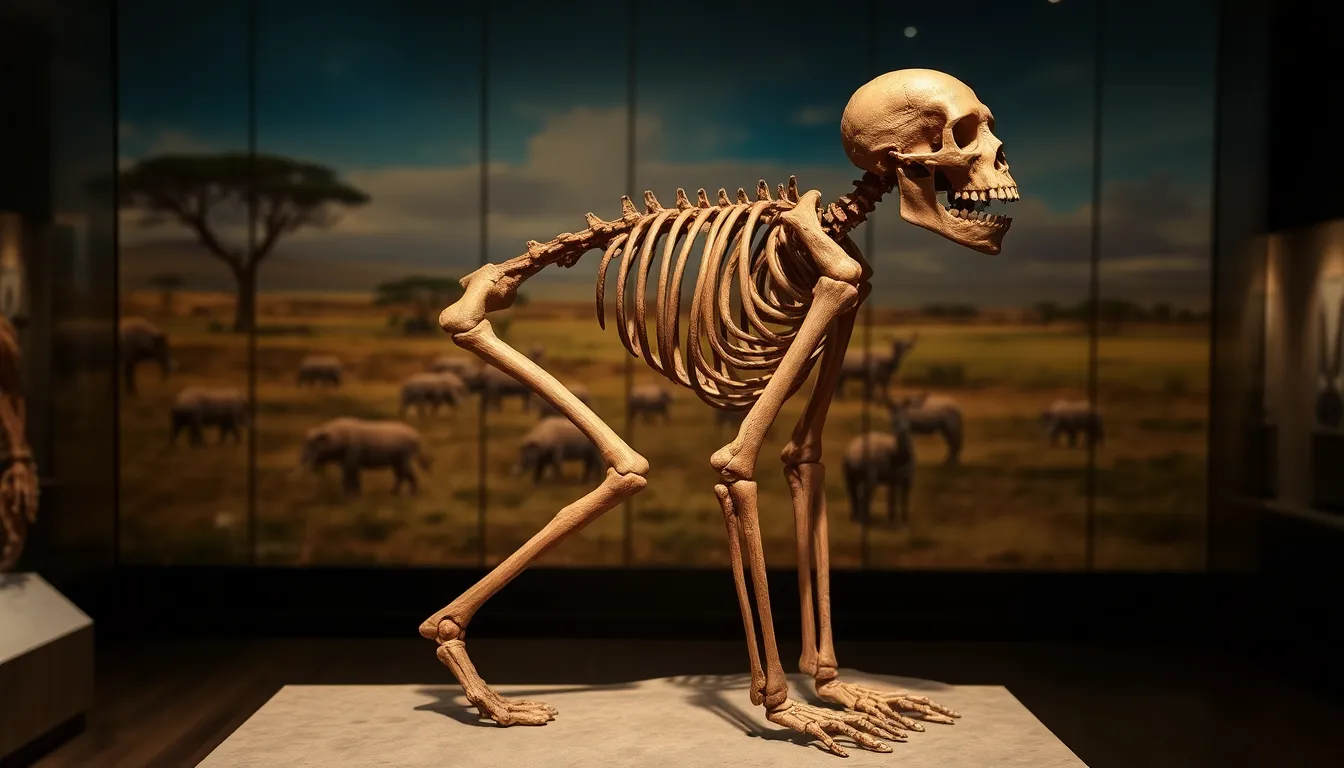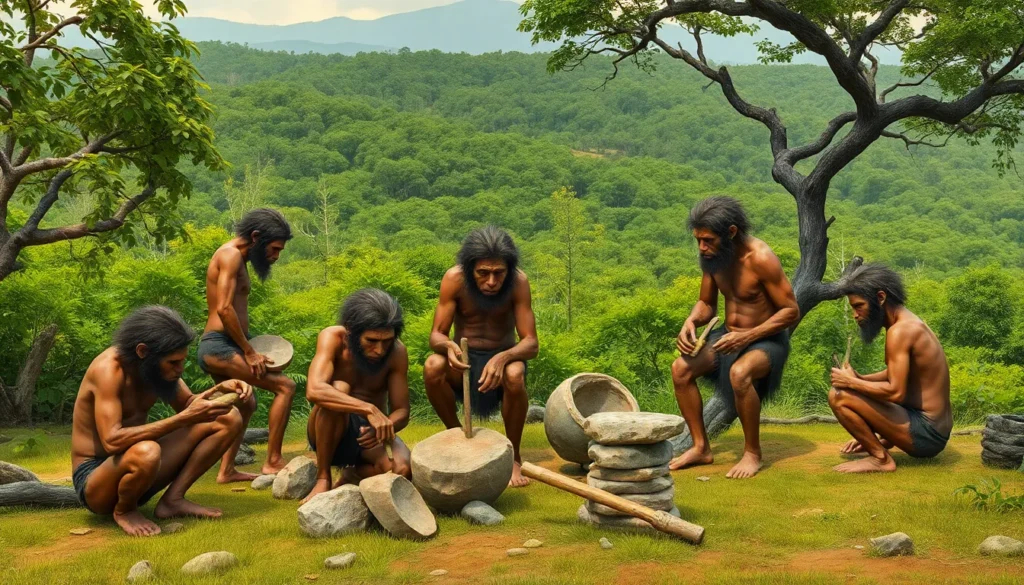Table of Contents
TogglePicture this: a time when the Earth was a wild, untamed place, and the only inhabitants were a few curious creatures. But who were the first people to strut their stuff on this planet? It’s a question that tickles the imagination and sparks countless debates. From ancient myths to groundbreaking scientific discoveries, the story of humanity’s origins is as captivating as it is complex.
The Concept of Early Humans
Early humans represent a significant chapter in Earth’s history, marking the beginning of human evolution and adaptation. Understanding who these early inhabitants were involves exploring scientific findings and anthropological research.
Defining ‘First People’
‘First people’ refers to the earliest members of the Homo genus, specifically Homo sapiens. Evidence suggests that these individuals emerged in Africa approximately 300,000 years ago. Characteristics of these early humans included bipedalism, tool use, and social structures. Research indicates that they developed complex languages and cultures over time. Many archaeological sites around the world provide insights into their daily lives and survival strategies.
The Emergence of Hominins
The emergence of hominins marks a crucial stage in human evolution, occurring around 6 to 7 million years ago. This phase involved the transition from primate ancestors to more human-like species. Ardipithecus and Australopithecus represent some key examples, displaying both ape-like and human-like features. Fossil discoveries have revealed their adaptations to environmental changes. From the use of simple tools to the formation of social groups, these developments played vital roles in survival and evolution. Consequently, they set the stage for the rise of modern humans.
Key Discoveries in Human Evolution

Fossil evidence and genetic research reveal critical insights into human evolution.
Fossil Evidence
Fossil discoveries illustrate the physical changes in early humans over millions of years. Notable fossils include those of Ardipithecus ramidus, which existed around 4.4 million years ago, showcasing traits like bipedalism. The Australopithecus afarensis, dating back 3.9 to 2.9 million years, demonstrates further adaptations toward modern human characteristics. Excavations such as those in East Africa have unearthed significant findings, including the famous “Lucy” skeleton. These fossils provide a timeline and context for understanding the emergence of the Homo genus, emphasizing the gradual development of traits like larger brain sizes and advanced tool use.
Genetic Research
Genetic research plays a vital role in tracing human lineage. Studies of ancient DNA reveal connections between modern humans and earlier hominins. Research indicates that Homo sapiens share DNA with Neanderthals and Denisovans, suggesting interbreeding occurred. By analyzing mitochondrial and nuclear DNA from various populations, scientists track migration patterns and adaptations to environmental changes. This genetic data enhances understanding of physical and behavioral traits developed by early humans and highlights their adaptability. Evidence of genetic diversity across populations also supports the theory of an African origin for modern humans approximately 300,000 years ago.
Notable Early Humans
Early humans played a significant role in shaping the trajectory of human evolution. Key species like Homo habilis and Homo erectus demonstrate the advancements made during this essential period.
Homo Habilis
Homo habilis, recognized as one of the earliest members of the Homo genus, lived around 2.4 to 1.4 million years ago. These early humans displayed a mix of primitive and more advanced traits. They had a larger brain size compared to earlier hominins, suggesting improved cognitive abilities. Tools made from stone were discovered alongside their fossils, indicating their capability for tool use. Evidence shows they likely scavenged for meat, highlighting the beginning of a more varied diet. The use of tools marked an essential step in their survival and adaptation.
Homo Erectus
Homo erectus emerged approximately 1.9 million years ago and represents a significant advancement in human evolution. This species is characterized by its more elongated limbs and larger brain size, which enhanced locomotion and intelligence. Evidence supports that they utilized fire for cooking, which improved nutrition and safety. Their tools became more sophisticated, indicating a reliance on culture for survival. Fossils found in Africa, Asia, and Europe point to their extensive migration patterns. Adaptations to various environments showcased their resilience and ingenuity as they spread across diverse landscapes.
Theories on the Origin of Modern Humans
Various theories explore how modern humans emerged and their journey across the globe. Two primary theories provide insight into this complex narrative.
Out of Africa Theory
The Out of Africa Theory posits that all modern humans descended from a common ancestor in Africa. Approximately 300,000 years ago, Homo sapiens first appeared on the continent. Small groups migrated out of Africa around 60,000 to 70,000 years ago. This migration led to the spread of modern humans into Europe, Asia, and beyond. Fossil evidence and genetic studies support this theory by tracing human lineage back to Africa. Archaeological discoveries, like the remains found in Ethiopia, affirm the timeline and locations of early migrations.
Multiregional Hypothesis
The Multiregional Hypothesis offers an alternative view, suggesting modern humans evolved simultaneously in different regions. Homo erectus migrated from Africa, settling in Asia and Europe about 1.9 million years ago. These populations adapted to their environments, leading to regional variations of Homo sapiens. According to this hypothesis, gene flow between these groups maintained a single species despite geographic separation. Fossils and morphological evidence point toward this complex web of development. This hypothesis emphasizes the role of local adaptations along with shared ancestry in shaping modern humans.
Cultural and Social Development
The development of early humans involved significant advancements in both tools and social structures.
Tools and Technology
Early humans demonstrated remarkable ingenuity in toolmaking. Stone tools emerged as essential items, aiding in tasks like hunting and gathering. These primitive tools included hand axes and choppers, facilitating efficient processing of food. Over time, innovation led to the creation of more sophisticated implements, such as blades and points. Artifacts found in archaeological sites across Africa reveal that these tools improved diet diversity. Evidence shows that Homo habilis, living from 2.4 to 1.4 million years ago, significantly contributed to these advancements. Their ability to craft tools reflects cognitive development essential for survival and adaptation.
Early Societies
Social structures among early humans evolved alongside technological advancements. Groups formed based on kinship, fostering cooperation and shared resources. These early societies engaged in collaborative hunting, significantly enhancing their chances of survival. Evidence of communal living appears in archaeological finds, indicating social bonds and communication. Ritualistic behaviors suggest an emerging culture, showcasing symbolic thought. Shared languages developed within these groups, strengthening social cohesion. As these societies grew, roles became more defined, laying the groundwork for future civilizations.
The story of the first people on Earth is a fascinating journey through time. It highlights the resilience and adaptability of early humans as they navigated a world filled with challenges. From the emergence of Homo sapiens in Africa to the innovative tool-making and social structures that followed, these pioneers laid the foundation for modern civilization.
Understanding their origins not only sheds light on human evolution but also connects us to our shared ancestry. As research continues to uncover new evidence, it deepens the appreciation for the complex narrative of humanity’s beginnings. The legacy of these first people remains a testament to the enduring spirit of survival and innovation that defines us today.







